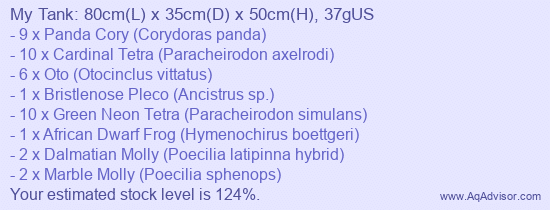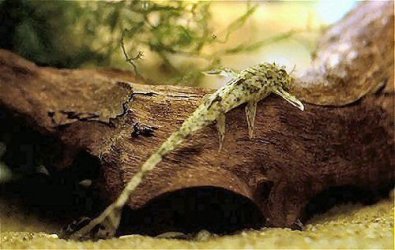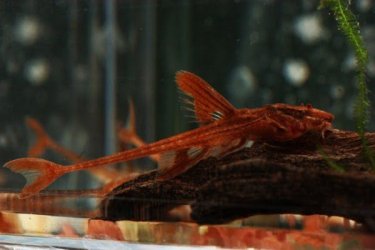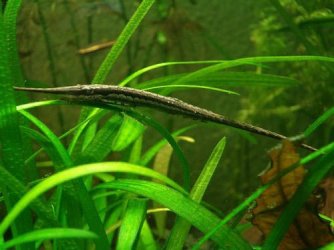You are using an out of date browser. It may not display this or other websites correctly.
You should upgrade or use an alternative browser.
You should upgrade or use an alternative browser.
Re stocking 125l
- Thread starter Mathew1991
- Start date
I wouldn't risk it, that's quite a bit over capacity unless you decide to get the 300 litre again, especially when you've indicated you think overstocking may have contributed to your current issues. ADF's are very sensitive to water quality so if you're slightly off with your water changes he'll probably be the first to go/get ill.Been having a play around on fish stock calculators
Come up with these ideas
It comes up slightly overstocked but with good water changes would this be ok
Or lower the ottos or don’t put them in
But I quiet like them
Am I misremembering but don't you have soft water and had issues with the mollies you bought? Adding more to what would be an overstocked tank with conditions that don't suit them doesn't feel like a sensible idea.
Having had a "slightly" overstocked tank before without realising, water changes weren't enough, I was overrun with cyanobacteria and killed everything bar 3 cories. It's not worth the risk.
Last edited:
I do have soft water
I’ve never had any issues with the mollies they have had babies a wile ago aswell the fry didn’t last long tho they all got ate
I wasent adding anymore Mollys the 4 on the list is what I have left after 2 died through this thing
I’ve never had any issues with the mollies they have had babies a wile ago aswell the fry didn’t last long tho they all got ate
I wasent adding anymore Mollys the 4 on the list is what I have left after 2 died through this thing
I don't know if I'm mixing this up with another thread, thought you were trying to rehome your mollies due to issues with your water.I do have soft water
I’ve never had any issues with the mollies they have had babies a wile ago aswell the fry didn’t last long tho they all got ate
I wasent adding anymore Mollys the 4 on the list is what I have left after 2 died through this thing
Either way I still wouldn't stock a tank to 124% capacity, it's asking for trouble. As others have said bringing the cardinals up to a higher number is the only thing I would do, especially with a pleco in there.
I did try and re home the mollies but couldn’t get them re honed so just sticking with them
Ok I’m just thinking that it looks like there isn’t anything in there with just cardinals and 4 mollies and the cat fish at the bottom
If I stick with what I have and up cardinals to 10
It comes back at 76 percent stocked
Ok I’m just thinking that it looks like there isn’t anything in there with just cardinals and 4 mollies and the cat fish at the bottom
If I stick with what I have and up cardinals to 10
It comes back at 76 percent stocked
First comment, you cannot rely on online calculator sites. Those programs cannot possibly take into account the factors that must be considered when combining two or more fish species. Tank size and numbers is not the important issue.
I mentioned some time back that this tank was not really suited to Bleeding Heart Tetras because of their size. But as you already had five or six of them, you then had only two options, either rehome them or get sufficient to keep them healthy and happy. You said they were getting nippy, which was to be expected in small numbers. Point is, a species of fish has inherent requirements that must be provided for, or they simply will not be healthy.
Otos are the last fish you should consider adding, because they frequently arrive in stores nearly starved and without a good biofilm which occurs in tanks that are established (not just cycled, but established) otos often don't make it. Added to an established tank so they have natural food (on all surfaces) they settle in and most will soon discover that the algae-based disks or whatever are food.
After the tank has been OK for a month, no deaths, it will be time to consider fish, and as others have agreed, the cardinals should be increased. Do you have floating plants yet? You can be getting these while you wait, it makes a huge difference to cardinals having that cover above them. Floating plants provide the shade that is present in most watercourses these fish come from, and the floaters significantly improve the water quality.
I mentioned some time back that this tank was not really suited to Bleeding Heart Tetras because of their size. But as you already had five or six of them, you then had only two options, either rehome them or get sufficient to keep them healthy and happy. You said they were getting nippy, which was to be expected in small numbers. Point is, a species of fish has inherent requirements that must be provided for, or they simply will not be healthy.
Otos are the last fish you should consider adding, because they frequently arrive in stores nearly starved and without a good biofilm which occurs in tanks that are established (not just cycled, but established) otos often don't make it. Added to an established tank so they have natural food (on all surfaces) they settle in and most will soon discover that the algae-based disks or whatever are food.
After the tank has been OK for a month, no deaths, it will be time to consider fish, and as others have agreed, the cardinals should be increased. Do you have floating plants yet? You can be getting these while you wait, it makes a huge difference to cardinals having that cover above them. Floating plants provide the shade that is present in most watercourses these fish come from, and the floaters significantly improve the water quality.
I don’t have the bh tetras any more so they are goneFirst comment, you cannot rely on online calculator sites. Those programs cannot possibly take into account the factors that must be considered when combining two or more fish species. Tank size and numbers is not the important issue.
I mentioned some time back that this tank was not really suited to Bleeding Heart Tetras because of their size. But as you already had five or six of them, you then had only two options, either rehome them or get sufficient to keep them healthy and happy. You said they were getting nippy, which was to be expected in small numbers. Point is, a species of fish has inherent requirements that must be provided for, or they simply will not be healthy.
Otos are the last fish you should consider adding, because they frequently arrive in stores nearly starved and without a good biofilm which occurs in tanks that are established (not just cycled, but established) otos often don't make it. Added to an established tank so they have natural food (on all surfaces) they settle in and most will soon discover that the algae-based disks or whatever are food.
After the tank has been OK for a month, no deaths, it will be time to consider fish, and as others have agreed, the cardinals should be increased. Do you have floating plants yet? You can be getting these while you wait, it makes a huge difference to cardinals having that cover above them. Floating plants provide the shade that is present in most watercourses these fish come from, and the floaters significantly improve the water quality.
So above in the comments is what I have left
No o haven’t got any plants I will look into some
I don’t have the bh tetras any more so they are gone
So above in the comments is what I have left
No o haven’t got any plants I will look into some
Yes, I understood this, I was merely pointing out that once you decide on a species, you need to ensure it has what it needs before you acquire them.
Can you suggest what I could put in please
Can you suggest what I could put in please
Yes, but I don't know where to begin because it is your aquarium and I do not know what you may like. There are hundreds of suitably-sized species, and well suited to your soft water, that could work. It is also not easy suggesting fish from a pretty much blank slate, both for not knowing what you like, but also the interactions of each species can vary and I could end up writing a novel to explain everything. I prefer it when members tell us what they have, and suggest "x" or "y" and we can easily point out the negatives and positives of "x" and "y".
I put up my list before of what I thought
So the Oto is out the question what about another showling fish
Yes, I saw that. One thing I would advise, is not having more than one species of Paracheirodon (the cardinal and green neon). I believe you have three cardinals left, I would leave these (or rehome them). P. axelrodi (cardinal) and P. simulans (green) are very closely related, and most sources suggest not keeping them together. The only time I have is when I first was able to acquire P. simulans and I already had P. axelrodi, I combined them until the latter died off from old age (which can take a decade if properly housed). P. simulans is more sensitive and delicate as a species, and it remains smaller, but the green/blue neon line is indeed a stunning sight when you have a group of 15+. I would go for 15 of these, up to 20, and leave the cardinals at three. They will shoal together, as I said genetically they are extremely close, the Cardinal Tetra and the Green/False Neon have 26 and 25 chromosomes respectively, while the common neon tetra has 16. This data may help too:
This species (Green Neon) shares identical habitat and water parameter requirements with the Cardinal Tetra, and the two species are sympatric over portions of their range. The species was discovered in 1962 from individuals that were mixed in with cardinal tetras. The pH of the habitat waters ranges from 3.4 to 4.8, with hardness so low it can hardly be measured with scientific equipment. Neither fish fares well in tanks with hard and basic (alkaline) water. To replicate their habitat, the aquarium should have a sand substrate, and plenty of aquatic plants like Echinodorus (swords), Cabomba, Pennywort, and a very good cover of floating plants. These fish have what Baensch called a light phobia. Water flow from the filter should be minimal, with subdued lighting. This species prefers the middle regions in the aquarium, unlike its cousin the Cardinal Tetra which prefers the lower regions.
The otos are fine, but wait a few months so they have a better chance of surviving. But in the area of algae-eating fish, as fish with unique and interesting behaviours and appearances, have a look at the Whiptail and Twig Catfish. Make sure they are the smaller species, as the "Royal" get much, much larger. Rineloricaria parva is the common Whiptail, and Farlowella vitatta the common Twig. I always had one of these in a quiet Amazonian-type aquarium. They are fine as one alone, or a group of 2 or 3. R.parva also has a red form which can be quite distinctive. Photos of all 3 below.
Attachments
Ok so if we forget the green neons and just up the cardinals then get another set of shoaling fish maybe
I think what @Byron Was saying is either stick just with the cardinals at 3 and add 15 P. simulans or stick with just the cardinals as the only tetras and take it from there. Me personally, I'd get another 17 cardinals to make a group of 20.
@Byron what is a good middle ground water temperature if someone keeps corydoras and cardinals together? About 77 or 78 F ??
I think Matthew has Panda cory
@Byron what is a good middle ground water temperature if someone keeps corydoras and cardinals together? About 77 or 78 F ??
I think Matthew has Panda cory
Yer that’s what I’m saying I will up the cardinals
But is there anything else I could add to the tank
But is there anything else I could add to the tank
Similar threads
- Replies
- 1
- Views
- 213
- Replies
- 2
- Views
- 457
- Replies
- 4
- Views
- 722
- Replies
- 11
- Views
- 498
- Replies
- 4
- Views
- 302






